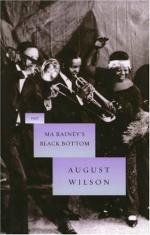|
This section contains 568 words (approx. 2 pages at 400 words per page) |

|
Harlem Renaissance
In 1927, when Wilson's play takes place, the Harlem Renaissance was in full swing. Black pride manifested itself across the country in art and politics. In poetry, Langston Hughes, Sterling Brown, and James Weldon Johnson wrote in black vernacular, using the rhythms of the blues and spirituals in their verse. Johnson's 1927 poetry collection, God's Trombone: Seven Negro Folk Sermons, one of the more popular works of the era, used the speech patterns of an old black preacher to capture the heart of the black idiom. Novelist Claude McKay detailed the life of working class blacks in Home to Harlem, and Jean Toomer told the story of poor southern blacks in her novel, Cane. Georgia-born, Ma Rainey and blues and jazz artists such as Louis Armstrong, Bessie Smith, and Ethel Waters signed contracts with recording studios such as Paramount Records to cut albums to be sold in cities...
|
This section contains 568 words (approx. 2 pages at 400 words per page) |

|




